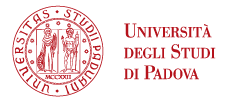
Sacred spaces and identity. Texts on foundation, iconography, worship and traditions in Italian Christian sanctuaries from Late Antiquity to the Middle Ages
Padova’s Task Group’s members are Chiara Cremonesi (Head of the group), Paolo Scarpi, Donatella Schmidt and Francesca Veronese. The team includes both experienced and young researchers; all of them have already dealt with the theme of sacred space connected with identity and intercultural patterns. This is possible thanks to the synergy between different personalities and skills, covering the history of religions, anthropology and archaeology, in a continuous reciprocal dialogue. Individual skillsets and the willingness to start a dialogue allow delving into the theme of sanctuaries and their cultural reflections, studying Late Antique and Antique Greek and Magno-Greek buildings and their Christian resemantization, whenever it occurred. The multifaceted skillset and openness to dialogue perfectly reflect the history of the host building of the research, the Department of Ancient World Sciences. It boasts a long-standing tradition in hosting prominent national and international research projects, involving the members of the Task Group themselves, whose stories are linked to philology, archaeology, history of religions and anthropology. Activities can be carried out thanks to the existence of “Tito Livio” Interdepartmental library, which hosts the impressive documentary heritage of the Department of Ancient History Sciences and Archaeology, with 104,632 volumes (about one thousand antiquities) and 702 subscriptions to magazines. Padua’s Group will also be joined by engineer Luigi Lovat, in charge of the ICT network infrastructure (IT, telecommunications and support for audiovisual technologies) of the Department, that will work on the computer processing of the database, following the methods implemented for the international CENOB project, financed by the Agence Nationale de la Recherche (ANR) headed by Jean-Daniel Du Bois from the École Pratique des Hautes Études in cooperation with Université Libre de Bruxelles and Padua’s University (Department of Ancient History Sciences). The project is joined by Chiara Cremonesi and Paolo Scarpi.
The main goal of the project is to investigate sanctuaries as sacred spaces where identities are built and reconstructed and an exchange occurs between the human and extra-human dimensions. It also deals with sanctuaries as places where practical intercultural activities occur: as a matter of fact, sanctuaries have always been the center of paths and journeys that cross and redefine geography and politics, society and economics, recalling mythical and historical memories, individual and collective experiences. They are places with a rich existential nature, where politics, aesthetics, religion and a therapeutic aspect all have a role to play. There, the sacred becomes a part of history through social and cultural negotiation and construction processes ( cfr. A. Brelich, Perché storicismo e quale storicismo, in “Religioni e civiltà”, 1, 1972, 7-28; D. Sabbatucci, La prospettiva storico-religiosa, Milan 1990; E. de Martino, Storia e metastoria, edited by M. Massenzio, Lecce 1995).
The project will especially focus on “water sanctuaries” in the Late Antique and Antique Greek and Magno-Greek period: they are places of worship where sea, river, swamp, spring waters act as catalysts, even when such places incur Christian resemantization. They are characterized by different forms of worship and attendance: hence, “water sanctuaries” are an operational conceptual tool that will be investigated both with a comparative and a cross-sector approach. The comparative approach will not remove facts from history; on the contrary, it will enhance the peculiarities of each sanctuary with the awareness that history “can only be made by distinguishing, i.e. identifying” (D. Sabbatucci, Presentazione a R. Pettazzoni, I misteri. Saggio di una teoria storico-religiosa, Cosenza 1997).
The following procedure will be implemented: 1) archaeological scouting of some places of worship where water is present, their topographic location, structures connected to waterways (pipes, tanks, fountains, tubs, wells); 2) collection and analysis of historical and literary evidence around sanctuaries and the role of “sacred” water; 3) interpretation of the material and symbolic dimension, aware that water acts as mediation channel between the human and extra-human dimension, yet is completely different in the framework of religious systems that have been inhabiting the Mediterraneum. In particular, the group will focus on the archaeological, historical and literary documents dealing with thermal waters’ therapeutic properties or waters that are said to be miraculous: the relation between water and healing has varying peculiarities according to the different contexts and meanings of illness and is not to be reduced to mere nosology (M. Augé and C. Herzlich, Il senso del male, Italian translation, Milan 1986; J. Benoist, Soigner au pluriel. Essais sur le pluralisme médical, Paris 1990; E. de Martino, La terra del rimorso. Contributo a una storia religiosa del Sud, Milan 1961).
link: www.firbspazisacri.uniba.it
The project ended in
2017
National Scientific Coordinator
Laura Carnevale (Università Aldo Moro di Bari)
Head of Padova's Task Group
Chiara Cremonesi





